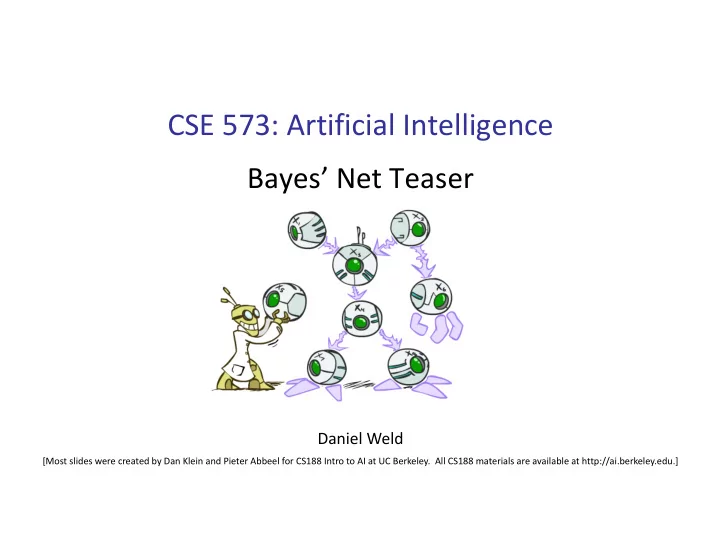

CSE 573: Artificial Intelligence Bayes’ Net Teaser Daniel Weld [Most slides were created by Dan Klein and Pieter Abbeel for CS188 Intro to AI at UC Berkeley. All CS188 materials are available at http://ai.berkeley.edu.]
Inference in Ghostbusters § A ghost is in the grid somewhere § Sensor readings tell how close a square is to the ghost § On the ghost: red § 1 or 2 away: orange § 3 or 4 away: yellow § 5+ away: green § Sensors are noisy, but we know P(Color | Distance) P(red | 3) P(orange | 3) P(yellow | 3) P(green | 3) 0.05 0.15 0.5 0.3 [Demo: Ghostbuster – no probability (L12D1) ]
Random Variables § A random variable is some aspect of the world about which we (may) have uncertainty § R = Is it raining? § T = Is it hot or cold? § D = How long will it take to drive to work? § L = Where is the ghost? § We denote random variables with capital letters § Like variables in a CSP, random variables have domains § R in {true, false} (often write as {+r, -r}) § T in {hot, cold} § D in [0, ¥ ) § L in possible locations, maybe {(0,0), (0,1), …}
Joint Distributions § A joint distribution over a set of random variables: specifies a probability for each assignment (or outcome ): T W P hot sun 0.4 § Must obey: hot rain 0.1 cold sun 0.2 cold rain 0.3 § Size of joint distribution if n variables with domain sizes d? § For all but the smallest distributions, impractical to write out!
Marginal Distributions § Marginal distributions are sub-tables which eliminate variables § Marginalization (summing out): Combine collapsed rows by adding T P hot 0.5 T W P cold 0.5 hot sun 0.4 hot rain 0.1 cold sun 0.2 W P cold rain 0.3 sun 0.6 rain 0.4
Conditional Probabilities § A simple relation between joint and marginal probabilities § In fact, this is taken as the definition of a conditional probability P(a,b) P(a) P(b) T W P hot sun 0.4 hot rain 0.1 cold sun 0.2 cold rain 0.3
Probability Recap § Conditional probability § Product rule § Chain rule § Bayes rule § X, Y independent if and only if: § X and Y are conditionally independent given Z: if and only if:
Probabilistic Inference § Probabilistic inference = “compute a desired probability from other known probabilities (e.g. conditional from joint)” § We generally compute conditional probabilities § P(on time | no reported accidents) = 0.90 § These represent the agent’s beliefs given the evidence § Probabilities change with new evidence: § P(on time | no accidents, 5 a.m.) = 0.95 § P(on time | no accidents, 5 a.m., raining) = 0.80 § Observing new evidence causes beliefs to be updated
Inference by Enumeration * Works fine with General case: We want: § § multiple query § Evidence variables: variables, too § Query* variable: All variables § Hidden variables: Step 3: Normalize Step 1: Select the Step 2: Sum out H to get joint § § § of Query and evidence entries consistent with the evidence × 1 Z
Example: Inference by Enumeration S T W P P(W=sun | S=winter)? summer hot sun 0.30 summer hot rain 0.05 1. Select data consistent with evidence summer cold sun 0.10 summer cold rain 0.05 winter hot sun 0.10 winter hot rain 0.05 winter cold sun 0.15 winter cold rain 0.20
Example: Inference by Enumeration S T W P P(W=sun | S=winter)? summer hot sun 0.30 summer hot rain 0.05 1. Select data consistent with evidence summer cold sun 0.10 2. Marginalize away hidden variables summer cold rain 0.05 (sum out temperature) winter hot sun 0.10 winter hot rain 0.05 winter cold sun 0.15 winter cold rain 0.20
Example: Inference by Enumeration S T W P P(W=sun | S=winter)? summer hot sun 0.30 summer hot rain 0.05 1. Select data consistent with evidence summer cold sun 0.10 2. Marginalize away hidden variables summer cold rain 0.05 (sum out temperature) winter hot sun 0.10 3. Normalize winter hot rain 0.05 winter cold sun 0.15 winter cold rain 0.20 S W P winter sun 0.25 winter rain 0.25
Example: Inference by Enumeration S T W P P(W=sun | S=winter)? summer hot sun 0.30 summer hot rain 0.05 1. Select data consistent with evidence summer cold sun 0.10 2. Marginalize away hidden variables summer cold rain 0.05 (sum out temperature) winter hot sun 0.10 3. Normalize winter hot rain 0.05 winter cold sun 0.15 winter cold rain 0.20 S W P winter sun 0.50 winter rain 0.50
Inference by Enumeration § Computational problems? § Worst-case time complexity O(d n ) § Space complexity O(d n ) to store the joint distribution
Don’t be Fooled § It may look cute… https://fc08.deviantart.net/fs71/i/2010/258/4/4/baby_dragon__charles_by_imsorrybuti-d2yti11.png 15
Don’t be Fooled § It gets big… P T F Q T F T F R T F T F T F T F http://img4.wikia.nocookie.net/__cb20090430175407/monster/images/9/92/Basilisk.jpg 0.1 0.05 0.2 0.07 0.03 0.05 0.1 0.3 16
The Sword of Conditional Independence! Slay I am a BIG joint the distribution! Basilisk! harrypotter.wikia.com/ Means: Or, equivalently: 17
Bayes’Nets: Big Picture
Recommend
More recommend